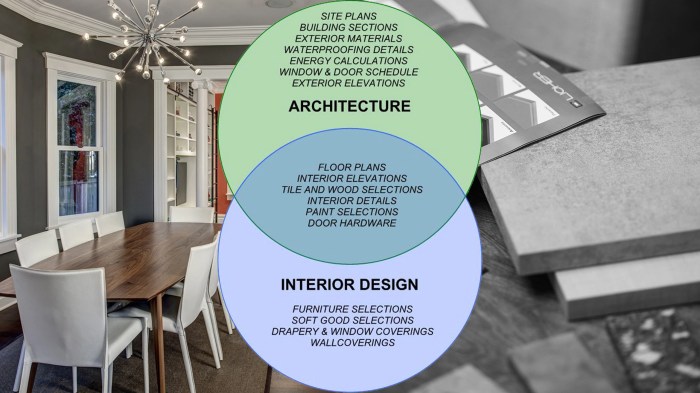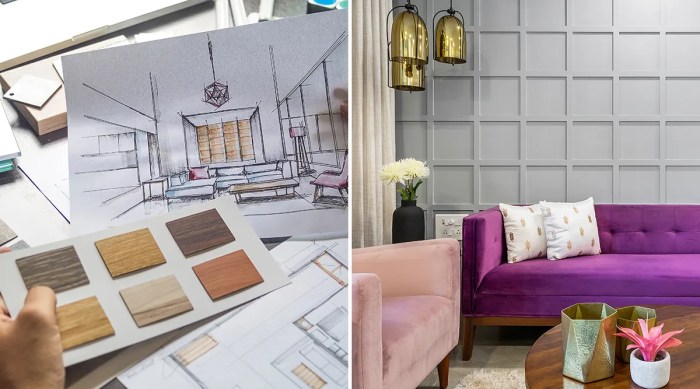Architects and interior designers play a crucial role in shaping the spaces we inhabit, from designing iconic buildings to creating stunning interiors that reflect our style and personality. This article delves into the distinct yet interconnected worlds of architecture and interior design, shedding light on their unique responsibilities, creative processes, and collaborative efforts that bring visions to life.
Definition of Architect and Interior Designer

An architect is a professional who designs and plans structures, focusing on the aesthetics, functionality, and safety of buildings. Their role involves creating detailed drawings and blueprints for construction projects, ensuring that the design meets building codes and regulations.Interior designers, on the other hand, specialize in creating functional and aesthetically pleasing interior spaces.
They work with clients to understand their needs and preferences, selecting furniture, color schemes, and decorative elements to enhance the overall design of a space.
Roles and Responsibilities of an Architect
Architects are responsible for:
- Creating designs and blueprints for buildings
- Ensuring compliance with building codes and regulations
- Collaborating with clients, engineers, and contractors
- Overseeing construction projects to ensure designs are implemented correctly
- Considering environmental and sustainability factors in their designs
Duties and Tasks of an Interior Designer
Interior designers typically:
- Consult with clients to determine design preferences
- Select furniture, fixtures, and decorative elements for interior spaces
- Create layouts and floor plans to optimize space utilization
- Coordinate with architects and contractors during the design and construction process
- Stay updated on current design trends and materials
Skills Comparison
Architects and interior designers both require creativity, attention to detail, and strong communication skills. However, architects focus more on structural elements and building codes, while interior designers specialize in creating inviting and functional interior spaces.
Projects Examples
Architects typically work on projects such as:
- Designing residential homes
- Planning commercial buildings
- Creating public spaces like parks and museums
Interior designers often work on projects like:
- Redesigning residential interiors
- Decorating commercial spaces like restaurants and offices
- Designing layouts for hotels and hospitality venues
Education and Training
To become an architect, individuals must complete a professional degree in architecture, which typically includes a Bachelor's degree followed by a Master's degree in Architecture. It is essential to attend a program accredited by the National Architectural Accrediting Board (NAAB).
Educational Requirements for Architects
- Completion of a Bachelor's degree in Architecture (5 years)
- Completion of a Master's degree in Architecture (1-5 years)
- Participation in an internship program (3-5 years)
Certifications and Licenses for Architects
- Passing the Architect Registration Examination (ARE)
- Obtaining licensure from the state in which they plan to practice
- Maintaining continuing education credits to keep their license active
Educational Path for Interior Designers
Individuals aspiring to become interior designers typically pursue a Bachelor's degree in Interior Design or a related field. Some may also choose to complete a Master's degree for further specialization.
Importance of Continuous Learning
Interior designers and architects must engage in continuous learning and professional development to stay updated on the latest trends, technologies, and building codes. This ongoing education ensures that they provide the best possible service to their clients and maintain their professional credentials.
Design Process

The design process is a crucial aspect of both architecture and interior design, involving various stages and steps to bring a project to fruition. While architects focus on the overall structure and exterior of a building, interior designers concentrate on creating functional and aesthetically pleasing interior spaces.
Architectural Design Process
The architectural design process typically involves the following steps:
- Programming: Defining the project requirements and objectives
- Schematic Design: Creating initial design concepts and sketches
- Design Development: Refining the chosen concept and incorporating more detailed elements
- Construction Documents: Producing detailed drawings and specifications for construction
- Permitting: Obtaining necessary approvals and permits for construction
- Construction Administration: Overseeing the construction process to ensure the design is implemented correctly
Interior Design Process
The stages of the interior design process include:
- Initial Consultation: Understanding the client's needs, preferences, and budget
- Concept Development: Creating a design concept including color schemes, furniture layout, and material selection
- Design Presentation: Presenting the design concept to the client for feedback and approval
- Design Development: Refining the design and selecting specific furnishings and finishes
- Implementation: Overseeing the installation and final touches to bring the design to life
Comparison of Approaches
Architects tend to focus on the overall structure, building systems, and exterior appearance of a project, while interior designers prioritize creating functional and aesthetically pleasing interior spaces. Architects work closely with engineers and contractors to ensure the structural integrity of a building, whereas interior designers collaborate with clients and vendors to select furnishings and decorations.
Tools and Software
Architects commonly use tools such as AutoCAD, Revit, and SketchUp for drafting and 3D modeling, while interior designers rely on software like SketchUp, 3ds Max, and Adobe Photoshop for creating visualizations and mood boards. These tools help architects and interior designers communicate their ideas effectively and bring their designs to life.
Collaboration and Communication
Effective collaboration and communication between architects and interior designers are crucial for the successful completion of a project. By working together seamlessly, they can ensure that the design vision is cohesive and meets the needs of the client.
Importance of Collaboration
Collaboration between architects and interior designers allows for a holistic approach to design, where both professionals can leverage their expertise to create spaces that are not only aesthetically pleasing but also functional and practical. By combining architectural elements with interior design concepts, they can achieve a harmonious balance that enhances the overall quality of the space.
Effective Communication with Clients
Architects and interior designers communicate effectively with clients by actively listening to their needs and preferences, translating their vision into tangible design concepts, and providing regular updates on the project's progress. Clear and open communication helps build trust and ensures that the final design reflects the client's desires.
Creating Cohesive Spaces
To create cohesive and functional spaces, architects and interior designers collaborate closely throughout the design process. They share ideas, provide feedback, and make decisions together to ensure that every aspect of the design aligns with the overall vision. By working in tandem, they can optimize the use of space, materials, and lighting to create a seamless and integrated environment.
Resolving Conflicts
Conflicts may arise during the collaboration process due to differing perspectives or priorities. Architects and interior designers can resolve conflicts by maintaining open lines of communication, seeking compromise, and focusing on the shared goal of delivering a successful project. By addressing issues promptly and constructively, they can navigate challenges and find solutions that satisfy all parties involved.
Final Summary

As we conclude our exploration of the dynamic realms of architect and interior designer, it becomes evident that these professions are not just about creating structures and spaces but about crafting experiences that resonate with individuals on a profound level.
The synergy between architecture and interior design continues to redefine our living environments, inspiring innovation and beauty in equal measure.
FAQ Explained
What are the key differences between an architect and an interior designer?
Architects focus on the overall design and structural integrity of buildings, while interior designers specialize in creating functional and aesthetically pleasing interior spaces.
Do architects and interior designers work together on projects?
Yes, collaboration between architects and interior designers is common, ensuring that both the exterior and interior of a building harmonize seamlessly.
What software tools do architects and interior designers commonly use?
Architects often use software like AutoCAD and Revit for drafting and 3D modeling, while interior designers may utilize programs like SketchUp and Adobe Photoshop for space planning and visualization.









